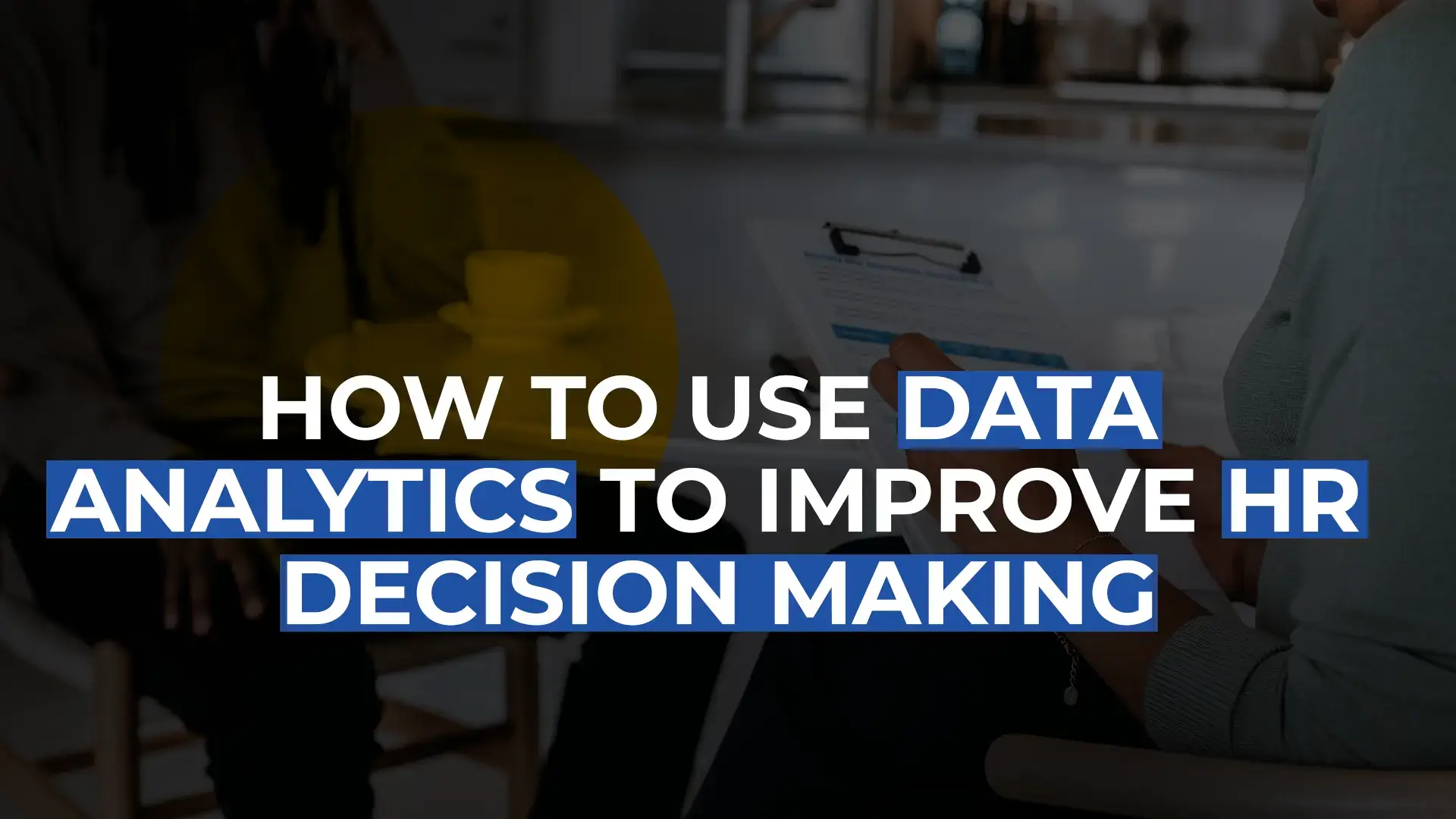How to Use Data Analytics to Improve HR Decision Making

Here's What We've Covered!
Hey there, HR enthusiasts! In today’s data-driven world, making informed decisions is key to success in every aspect of business, including human resources (HR). Gone are the days of relying solely on gut instincts and guesswork when it comes to managing talent and shaping organizational strategies. Enter data analytics – a powerful tool that can revolutionize HR decision-making processes and take them to the next level.
In this blog, we’re diving into the exciting realm of data analytics and exploring how it can empower HR professionals to make better-informed decisions. Whether you’re an HR manager, a budding analyst, or simply curious about the intersection of data and HR, get ready to unlock the potential of data analytics in transforming the way we approach HR decision making.
We’ll be demystifying the world of data analytics, shedding light on its significance, and equipping you with practical tips on how to leverage data to drive HR strategies forward. So, fasten your seatbelts and get ready to embark on a journey that will unleash the power of data, all for the betterment of your organization and its most valuable asset – its people.
But first, let’s answer the fundamental question:
What is Data Analytics in HR?
Data analytics in HR refers to the process of collecting, analyzing, and interpreting relevant HR data to gain insights that inform decision making. By harnessing data from various sources, such as employee records, performance metrics, engagement surveys, and recruitment data, HR professionals can uncover patterns, trends, and correlations that provide valuable insights into workforce dynamics, employee behavior, and organizational performance.
Why Data Analytics Matters for HR Decision Making:
Traditionally, HR decisions were often made based on intuition or limited data. However, with the advent of data analytics, HR professionals now have the opportunity to make evidence-based decisions that are grounded in quantitative insights. Data analytics allows HR teams to move beyond assumptions and biases, enabling them to identify strengths, weaknesses, and areas for improvement in talent management, recruitment, employee engagement, and more.
By harnessing the power of data analytics, HR professionals can:
- Gain a deeper understanding of their workforce and identify patterns and trends that may impact productivity, engagement, and retention.
- Make data-driven decisions when it comes to talent acquisition, ensuring that the right candidates are hired for the right roles.
- Enhance employee engagement initiatives by identifying drivers of satisfaction, measuring sentiment, and tailoring interventions to improve overall employee experience.
- Identify skill gaps and training needs, enabling targeted learning and development programs that align with organizational goals.
- Monitor and measure the impact of HR initiatives and interventions, allowing for continuous improvement and course correction when needed.
Bonus Tip: Want to make the most of this opportunity in the upcoming years? Enroll into Data Analytics course today from premiere institutions like IMS Proschool and get your dream job as an HR super soon!
Now, let’s understand a few key reasons why data analytics has become indispensable in the HR field:
Benefits of Using Data Analytics in HR Decision Making
-
Strategic Decision Making:
Data analytics equips HR professionals with the ability to make strategic decisions based on objective evidence. By analyzing data, HR teams can identify trends, patterns, and correlations that influence workforce dynamics, enabling them to proactively address challenges and capitalize on opportunities.
-
Talent Acquisition and Retention:
Recruiting and retaining top talent are critical HR functions. Data analytics enables organizations to optimize their talent acquisition strategies by identifying the most effective sourcing channels, assessing candidate fit, and predicting employee retention rates. This helps HR professionals make informed decisions that ensure the right people are in the right roles, resulting in reduced turnover and enhanced productivity.
-
Employee Engagement and Performance:
Engaged employees are the backbone of a successful organization. Data analytics enables HR professionals to measure and monitor employee engagement levels, identify factors that drive satisfaction, and tailor interventions to enhance employee experience. By understanding what motivates employees and addressing their needs, organizations can foster a positive work environment and improve overall performance.
-
Learning and Development:
Investing in employee development is essential for both individual growth and organizational success. Data analytics helps HR professionals identify skill gaps, assess training needs, and design targeted learning programs that align with organizational goals. By tailoring development initiatives based on data insights, HR teams can enhance employee skills, boost engagement, and drive innovation within the organization.
-
Measuring HR Impact:
Data analytics provides HR professionals with the means to measure the effectiveness and impact of their initiatives. By tracking key HR metrics, such as recruitment cost per hire, training ROI, or employee satisfaction scores, HR teams can evaluate the success of their programs and make data-driven adjustments to continuously improve HR practices.
Overwhelmed with the potential of Data Analytics in HR industry? Congratulations! It’s your chance to take the next step of learning this skill with IMS Proschool’s Data Analytics Course and make your mark in this industry.
Become a Certified Data Analyst in 1 year
Let’s move ahead and explore some practical examples of how data analytics can be applied in HR:
Examples of Data Analytics in HR:
-
Predictive Analytics for Succession Planning:
By analyzing employee performance data, career progression, and potential indicators, HR teams can use predictive analytics to identify high-potential employees for succession planning. This enables organizations to groom future leaders and ensure a smooth transition of key roles.
Also Read – What Is Predictive Analytics? Usage, Algorithms & How To Learn
-
Sentiment Analysis for Employee Engagement:
Using natural language processing techniques, HR professionals can analyze employee feedback, surveys, and social media sentiment to gauge overall employee satisfaction. This helps identify areas of improvement, address concerns, and develop targeted engagement initiatives.
-
Diversity and Inclusion Analytics:
Data analytics can play a crucial role in monitoring diversity and inclusion efforts. By analyzing demographic data, hiring patterns, and promotion rates, HR teams can identify potential biases, implement corrective measures, and promote a more inclusive workplace culture.
So data enthusiasts! After brushing up your basics in data analytics and HR, let us dive deep to find out how to leverage the power of data analytics to collect HR Data.
-
How to leverage Data Analytics to Collect HR Data
The first step in this process is to collect the right data. Gathering HR data provides the foundation for insightful analysis and informed decision making. So, let’s roll up our sleeves and explore the various types of HR data that can be collected, as well as the tools and techniques that can be used to gather this valuable information.
Become a Certified Data Analyst in 1 year
Types of HR Data to Collect:
-
Employee Demographics:
Understanding your workforce starts with collecting demographic data. This includes information such as age, gender, education level, years of experience, and job titles. Demographic data provides a holistic view of your employees and can be useful in identifying diversity, equity, and inclusion initiatives, workforce planning, and targeted talent development strategies.
-
Performance Data:
Tracking performance metrics is crucial for evaluating employee productivity and contribution to organizational goals. Performance data may include key performance indicators (KPIs), individual or team goals, sales figures, customer feedback, and performance reviews. Collecting this data helps HR professionals assess employee performance, identify top performers, and provide targeted feedback and recognition.
-
Employee Feedback Surveys:
Surveys are an effective tool for gathering employee feedback on various aspects of their work experience. These surveys can cover topics such as job satisfaction, engagement levels, work-life balance, leadership effectiveness, and training needs. Employee feedback surveys provide valuable insights into the employee experience and help identify areas for improvement within the organization.
-
Exit Interviews:
When employees leave an organization, conducting exit interviews can provide valuable feedback on their reasons for departure, overall satisfaction, and suggestions for improvement. Exit interviews offer insights into employee retention strategies, potential issues within the organization, and opportunities for enhancing the employee experience.
Become a Certified Data Analyst in 1 year
Now that you know type of data to be collected, let us understand Tools and Techniques that will assist you in collecting HR Data:
Tools and Techniques for Collecting HR Data
-
Surveys:
Online surveys, such as web-based questionnaires or email surveys, are commonly used to collect HR data. They offer a structured and efficient way to gather information from a large number of employees. Surveys can be customized to cover specific topics and can include multiple-choice questions, rating scales, or open-ended questions to gather qualitative feedback.
-
Interviews:
Interviews, whether individual or group-based, provide an opportunity for HR professionals to have in-depth conversations with employees. Structured interviews follow a predefined set of questions, while unstructured interviews allow for more open-ended discussions. Interviews offer qualitative insights and allow for a deeper understanding of employees’ thoughts, experiences, and perspectives.
-
Focus Groups:
Focus groups bring together a small group of employees to discuss specific topics or issues. This interactive setting encourages participants to share their experiences, opinions, and suggestions. Focus groups provide rich qualitative data and allow for group dynamics and collaboration in generating insights.
-
Employee Record Systems:
Organizations often maintain employee record systems that capture essential HR data, such as employee demographics, employment history, training records, and performance evaluations. These systems streamline data collection and provide a centralized repository for HR data, making it easily accessible for analysis and reporting.
Now that we’ve collected a treasure trove of HR data, it’s time to unleash its power through accurate interpretation and application. Interpreting HR data accurately is crucial because it allows HR professionals to make informed decisions that drive organizational success. So, let’s put on our analytical hats and explore the importance of interpreting HR data correctly, along with some exciting examples of how data analytics can revolutionize HR decision making.
Become a Certified Data Analyst in 1 year
The Importance of Interpreting HR Data Accurately:
Interpreting HR data accurately is like deciphering a secret code. It unveils hidden insights and patterns that are instrumental in understanding the current state of your workforce and making strategic decisions. Here’s why it’s so important:
-
Informed Decision Making:
Accurate interpretation of HR data provides the foundation for informed decision making. It enables HR professionals to move beyond assumptions and rely on evidence-based insights when designing talent management strategies, implementing employee development programs, or addressing organizational challenges.
-
Identifying Trends and Patterns:
Interpreting HR data helps identify trends and patterns that may not be immediately apparent. By analyzing historical data and current workforce metrics, HR professionals can uncover correlations, anomalies, and emerging trends. This allows them to proactively address potential issues and capitalize on opportunities.
-
Predictive Analytics:
Accurate interpretation of HR data sets the stage for predictive analytics. By analyzing historical data and identifying patterns, HR professionals can make predictions about future workforce trends. This can include forecasting turnover rates, identifying high-potential employees, or predicting training needs. Predictive analytics helps organizations stay ahead of the curve and make proactive decisions to optimize their talent management strategies.
Examples of Using HR Data Analytics to Make Informed Decisions:
-
Identifying Training Needs:
By analyzing performance data and skills assessments, HR professionals can identify skills gaps within the organization. This enables them to design targeted training programs to enhance employee capabilities and align skill development with organizational goals. For example, data may reveal a need for additional sales training, prompting HR to invest in specific sales techniques or product knowledge workshops.
-
Evaluating Performance:
HR data analytics allows for a comprehensive evaluation of employee performance. By analyzing performance metrics, feedback, and goal achievement data, HR professionals can objectively assess individual and team performance. This helps identify top performers, recognize high potential employees, and provide targeted feedback for improvement. Data-driven performance evaluations promote fairness and transparency in performance management processes.
-
Predicting Turnover:
Analyzing turnover data and identifying patterns can help predict potential turnover risks. By analyzing factors such as employee engagement, job satisfaction, and career development opportunities, HR professionals can identify employees who may be at risk of leaving the organization. This allows them to implement retention strategies and take proactive measures to address employee concerns, ultimately reducing turnover rates.
-
Strategic Workforce Planning:
Data analytics enables HR professionals to strategically plan for the future workforce needs of the organization. By analyzing demographic data, retirement projections, and talent acquisition metrics, HR teams can identify potential skill shortages, succession planning needs, and recruitment strategies. This allows organizations to build a robust talent pipeline and ensure a smooth transition during periods of change.
While data analytics holds incredible potential in transforming HR decision making, it’s essential to acknowledge the challenges and opportunities that come with it. As we delve deeper into the world of HR data analytics, let’s explore the hurdles we may encounter and the exciting possibilities that lie ahead. Buckle up, because we’re about to navigate the challenges and embrace the opportunities of using data analytics in HR!
Challenges in Using Data Analytics in HR:
-
Data Quality and Availability:
One of the key challenges in HR data analytics is ensuring the quality and availability of data. HR professionals often face issues with data accuracy, completeness, and consistency. Incomplete or unreliable data can lead to flawed insights and hinder effective decision making. Establishing robust data collection and management processes is vital to address this challenge.
-
Data Privacy and Ethical Considerations:
Using HR data raises concerns about privacy and ethical considerations. HR professionals must ensure compliance with data protection regulations and ethical guidelines to safeguard employee privacy. Balancing the use of data analytics with ethical practices is crucial to maintain trust and transparency within the organization.
-
Skill Gaps and Data Literacy:
Leveraging data analytics requires a certain level of technical expertise and data literacy. HR professionals may face skill gaps in terms of data analysis, statistical methods, and data visualization. Bridging these skill gaps through training and upskilling initiatives is essential to effectively interpret and apply HR data.
While there are challenges in Data Analytics, it also offers multiple opportunities that weigh more than it’s short comings. So, let’s explore them together!
Opportunities in Using Data Analytics in HR:
-
Predictive Analytics and Forecasting:
Data analytics provides HR professionals with the opportunity to move from reactive to proactive decision making. By using predictive analytics, organizations can forecast trends, such as turnover rates, identify skill gaps, and predict future talent needs. This enables HR to develop strategic workforce plans and make data-driven decisions that positively impact the organization’s bottom line.
-
Employee Experience Enhancement:
HR data analytics opens up avenues for improving the employee experience. By analyzing employee feedback, engagement surveys, and performance data, HR professionals can gain valuable insights into the factors that influence employee satisfaction and engagement. This knowledge empowers organizations to design targeted initiatives and create a positive work environment that fosters employee well-being and productivity.
-
Talent Acquisition and Retention Optimization:
Data analytics revolutionizes talent acquisition and retention strategies. By analyzing recruitment data, HR professionals can identify the most effective sourcing channels, assess candidate fit, and predict employee retention rates. This helps organizations attract and retain top talent, resulting in improved productivity, reduced turnover, and a competitive edge in the market.
Conclusion:
Congratulations, data-driven HR enthusiasts! We’ve explored the incredible world of data analytics and its potential to revolutionize HR decision making. By harnessing the power of HR data, we can unlock valuable insights, make informed decisions, and drive organizational success. But remember, this journey is just beginning, and there’s so much more to explore and learn.
So, don’t miss out on this incredible chance to become a data analytics champion in the HR field. Visit the IMS Proschool website today and embark on a transformative learning journey that will supercharge your career and make you an invaluable asset to your organization.
Remember, the future of HR decision making lies in the power of data analytics. Embrace this exciting field, equip yourself with the right skills, and watch as you elevate HR practices to new heights. Get ready to unleash the power of data and become a true HR data analytics rockstar!
Happy data analyzing and best of luck on your data-driven HR journey!
Resent Post
>
Emerging commerce career options in India (2026): From CA to Data Analyst
>
ACCA Opportunities You Didn’t Know About – Think Beyond Audit!
>
Which Courses After 12th Commerce With High Salary Are in Demand Worldwide?
>
How to Find ACCA Jobs Online After Qualifying: Real Portals, Tips & Career Guidance
>
Financial Modelling Classes in Hyderabad: Your Guide to the Best Institutes
Follow Us For All Updates!



